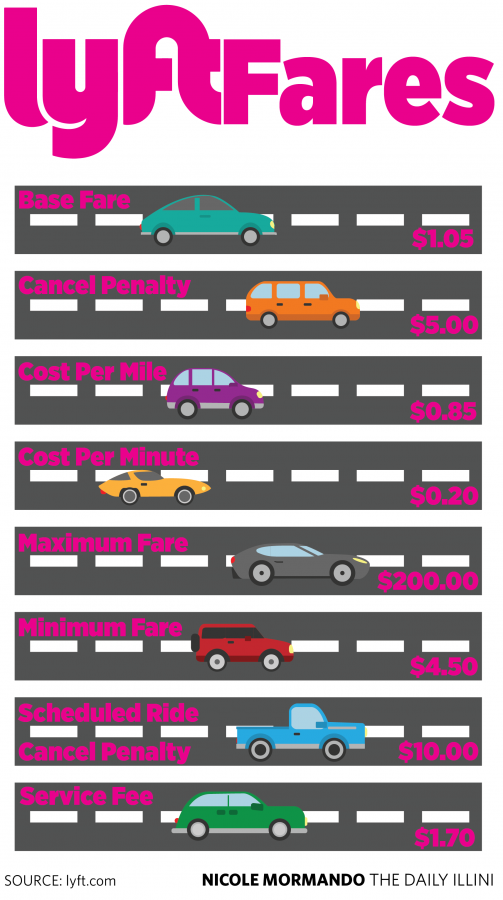C-U welcomes Lyft: The ride-sharing battle begins
Dec 8, 2016
Last updated on Dec. 19, 2016 at 12:00 p.m.
With temperatures below freezing and limited bus services during the holidays, getting around becomes more difficult. Ride-hailing services are a convenient alternative.
For David Gutierrez, senior in ACES, ride-hailing services are beneficial in the colder months when he needs to get to the Illinois Terminal with his luggage to catch his train home.
He said when students need to travel longer distances, ride-hailing services like Lyft and Uber are a pretty convenient perk for students around campus.
About a month ago, Uber’s main competitor, Lyft, went live in C-U. Uber has been live in the area since February 2015.
Get The Daily Illini in your inbox!
The ride-hailing services allow users to request rides from local drivers using their own vehicles through an app that is available on both Apple and Android devices.
Once a user requests a ride, he or she is connected with a driver nearby. Through the app, users can see a picture of their driver, as well as the vehicle’s make, model and license plate number. These features function as safety measures so getting into a car with a stranger is a little less frightening.
“I think Lyft’s prices are better in the city, but when it comes to a college campus they’re pretty comparable,” said Marcus Owerko, senior in AHS. “But for service, I would say that Uber is a little bit easier to use than Lyft.”
In many of their functionalities, Uber and Lyft are highly similar.
One key difference is Lyft’s advertising campaign promoting the slogan “your friend with a car.” Lyft drivers are encouraged to be more friendly toward passengers and make conversation with their users. Lyft drivers are also encouraged to offer extra amenities like phone chargers and bottles of water.
“I don’t know how different they are price-wise, but I like Uber because that’s what I’m more used to, and I already have the app and an account set up for it,” Gutierrez said. “In general, I just don’t use those services that much so I probably wouldn’t go through the effort of downloading (Lyft).”
While prices are very similar for regular rides between Uber and Lyft, discounts for new riders vary greatly. Lyft offers $55 in ride credit over the first 11 rides, while Uber offers one free ride up to $22.
In Champaign, both Uber and Lyft offer two types of cars. Riders can request a car with four seats or one with six for a higher price.
Both apps also offer a “fare split” feature that allows riders to share the price of the ride more easily.
For both ride-hailing services, employees can benefit by driving during “Prime Time” periods. Throughout these intervals, riders pay a higher fare because the supply of drivers is lower than the demand.
“I’ve only used Uber, but I would use Lyft in the future,” said Connor Robbs, junior in LAS. “I think the app is really easy to use and the drivers come pretty fast.”
One critique of the service on campus is that it may discourage students from getting exercise by walking across campus. Although buses are free for students, some have limited service on weekends and nights.
“I will say in my opinion, they’re probably overused or unnecessary in a lot of circumstances, like walking maybe two blocks to a bar or something like that,” Gutierrez said of the ride-hailing apps.
Lyft and Uber typically offer lower fares than cab services, so they may be useful to students who need to go shopping downtown or around Marketplace Mall. They can also take riders to any area where buses may not run at all.
“It provides a pretty cheap and easy way to get around campus and take care whatever you need to take care of without having a car on campus,” Owerko said.






